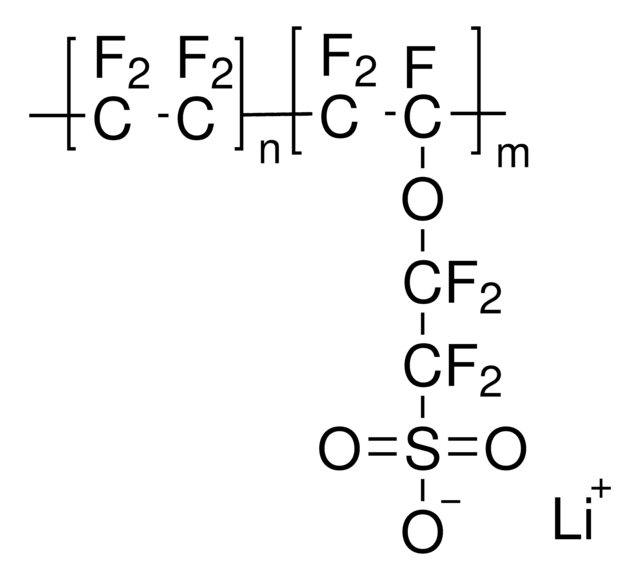推薦產品
等效分子量
1,000
包含
45% water
環保替代產品特色
Design for Energy Efficiency
Learn more about the Principles of Green Chemistry.
sustainability
Greener Alternative Product
濃度
5 wt. % in mixture of lower aliphatic alcohols and water
折射率
n20/D 1.368
bp
91-104 °C
密度
0.924 g/mL at 25 °C
環保替代類別
, Enabling
InChI
1S/C7HF13O5S.C2F4/c8-1(9)2(10)24-5(15,16)3(11,4(12,13)14)25-6(17,18)7(19,20)26(21,22)23;3-1(4)2(5)6/h(H,21,22,23);
InChI 密鑰
FOYUGSIADQEOEK-UHFFFAOYSA-N
尋找類似的產品? 前往 產品比較指南
一般說明
應用
包裝
法律資訊
訊號詞
Danger
危險分類
Eye Dam. 1 - Flam. Liq. 2 - STOT SE 2 - STOT SE 3
標靶器官
Eyes,Central nervous system, Respiratory system
儲存類別代碼
3 - Flammable liquids
水污染物質分類(WGK)
WGK 3
閃點(°F)
68.0 °F - closed cup
閃點(°C)
20 °C - closed cup
分析證明 (COA)
輸入產品批次/批號來搜索 分析證明 (COA)。在產品’s標籤上找到批次和批號,寫有 ‘Lot’或‘Batch’.。
文章
Materials Issues in Polymer Electrolyte Membrane Fuel Cells
Proton exchange membrane (PEM) fuel cells operate at relatively low temperatures and are composed of two electrodes and a conductive elecrolyte.
Advances in the electrochemical conversion of water to and from hydrogen and oxygen have principally been achieved through the development of new materials and by understanding the mechanisms of the degradation of proton exchange membrane fuel cells (PEMFC) during operation.
Advances in the electrochemical conversion of water to and from hydrogen and oxygen have principally been achieved through the development of new materials and by understanding the mechanisms of the degradation of proton exchange membrane fuel cells (PEMFC) during operation.
我們的科學家團隊在所有研究領域都有豐富的經驗,包括生命科學、材料科學、化學合成、色譜、分析等.
聯絡技術服務









